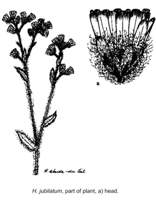Origin of name:
The joyous epithet commemorates the provenance of the type specimen.
Diagnostic characters:
Large spathulate leavesBracts whiteCompact to branched inflorescence
Description:
Annual herb, branching from the base, stems erect or decumbent, 100�250 mm long, loosely branched, thinly white-woolly, distantly leafy. Leaves mostly 8�30 x 5�15 mm, smallest under the heads, elliptic, obovate or oblanceolate, obtuse or acute, mucronate, base half-clasping, both surfaces greyish-white woolly-cobwebby. Heads heterogamous, campanulate, 3.5�4 x 2.5 mm, mostly crowded in terminal cymose panicles, subterminal heads sometimes solitary or 2�3 at the tips of nude branchlets up to 30 mm long. Involucral bracts in c. 5 series, graded, outer pellucid, pale straw-coloured, backs woolly, inner 2 series subequal, about equaling the flowers, tips obtuse, opaque snow-white, scarcely radiating. Receptacle nearly smooth. Flowers c. 35�41, 10�14 female, 24�29 homogamous. Achenes 0.75 mm long with myxogenic hairs. Pappus bristles many, equaling corolla, tips scabrid, bases nude, not cohering.
Flowering between September and November.
Distribution:
Recorded only from Namaqualand, near Lekkersing and Doornrivier.
Succulent Karoo Biome.
Taxonomy:
Literature:
Helichrysum jubilatum Hilliard in Flora of southern Africa 33,7 (2): 179 (1983).
Type:
Cape, Namaqualand div., Richtersveld, c. 5 miles E. of Lekkersing on road to Stinkfontein, kloof in hill south of the road, annual, disc whitish, 7 xi 1962, Nordenstam 1823 (S, holo.; E, iso.).
Synonym(s):
Vouchers:
Herre STE 12205 (STE); Nordenstam 1823 (S; E).

